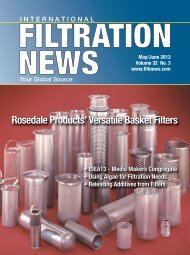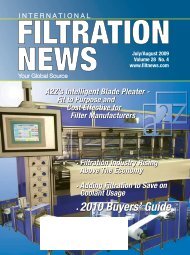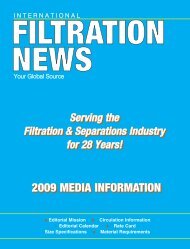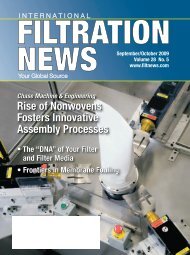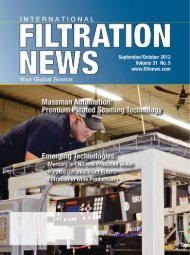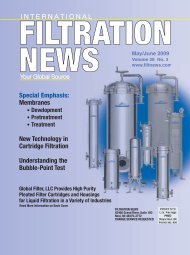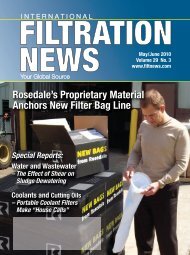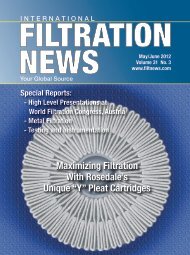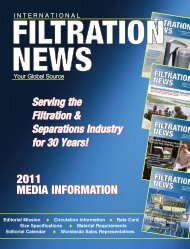Cartridge | <strong>Filtration</strong>cles. Commercially, a series of circumferentialcuts is made into the cartridge.However, the cartridge may also beturned on a machine tool to produce aspiral groove on the outer surface.However, grooves in the surface substantiallyweaken the physical strengthof the filter. In addition, the operationcreates circular lands, i.e., the regionsthat are left between the grooves. Toomany grooves in a given length of thecartridge will leave lands that are notthick enough to support themselves orto resist minor blows without breaking.This is particularly true in filters inwhich the outer surface into which thegrooves are cut is comprised of relativelylarge fibers. These fibers have relativelyfew intersections at which theycan be bonded together by the resin.Consequently, these lands are more susceptibleto breakage.In addition, the grooving processcreates particulate debris as well as altersthe surface structure of the filter.These minute particles often adhere tothe outer surface of the filter. Theirpresence is obvious. A common salestechnique is to tap a grooved cartridgeon a white sheet of paper placed on apotential customer’s desk. The appearanceof the dark particulate debris isoften sufficient to convince theprospective buyer that selection of anon-grooved competitive cartridge isthe wiser choice.One attempt to eliminate this sourceof media migration is to post-dip themachined cartridge in a resin bath tofurther saturate the outer surfaces 4 . Althoughthis process does fix the minuteparticles to the fiber matrix, it also altersthe cartridge’s void volume andhence its performance. Therefore, thecure may be worse than the disease.Resin bonded filter cartridges are operatedwith the flow direction from theoutside to the inside. Therefore, the30 • August 2013 • www.filtnews.comvast majority of these particles are removedfrom the filtrate as it passesthrough the cartridge matrix.A less obvious and more sinistercontributor to media migration is theuse of short fibers, i.e., those less than1/2” in length. Short filters have fewerintersections or points of contact thando longer fibers. Therefore, they can bemore readily separated from the cartridgematrix. Furthermore, they canexist anywhere within the element’sstructure. These particles do not haveto migrate through the entire cartridgeto contaminate the filtrate as do theparticles generated on the outer surfaceby the grooving operation.This problem is particularly acute inresin-bonded cartridges produced bythe vacuum deposition process. Theaqueous dispersions are often preparedusing both chopped linters and reclaimedfiber. Although incorporationof linters and reclaimed fiber providessignificant manufacturing cost reductions,the resultant cartridges exhibit ahigher degree of media migration thanequivalent cartridges produced by theother processes using higher-gradefibers. Neither can these cartridges bemarketed as “silicone free”, a necessityfor many coatings applications.IMPREGNATED MAT PROCESSESIn this section, the processes used toform fiber glass resin bonded cartridges,and compound layer resinbonded cartridges are discussed.Fiber Glass Resin Bonded Cartridges:In the process for producing fiberglass filter cartridges, molten glass is firstdrawn into thin glass fibers. These fibersare both extremely thin and uniform.The fibers are sprayed with an adhesivebinder as they are blown into a collectionchamber, in which the coated fibersare formed into uniform mats. Thesemats are then cut into sheets of predeterminedsizes to be rolled on a mandrelto form fiberglass tubes.After the cartridges are cured in anoven, they are first ground to the requiredouter diameter and subse-
quently grooved. In the final processsteps, the cartridges are cut to lengthand support cores are inserted prior tocovering with protective socks.The use of the very fine glass fiberscombined with high void volume yieldsa cartridge that exhibits high dirt holdingcapacity and long life. However, theresultant cartridge is also relatively soft.Therefore, the cartridge is susceptible todistortion, which can result in unloading.Consequently, its maximum operatingdifferential pressure is less thancompetitive resin bonded cartridges.Furthermore, it is the only resinbonded cartridge that requires a core,usually metal, to provide support.The combination of the fiberglassfibers and metal support core increasesthe costs of disposal. Unlike its polymericresin bonded competitors, fiberglass resin bonded cartridges cannot besimply incinerated.Although the melt spinning ofmolten glass yields the long fibers thatare preferred for maximum cartridge efficiency,these fibers are inherently brittle.Therefore, they are moresusceptible to breakage than are polymericfibers. Consequently, an outersock is used to protect the cartridgeduring handling as well as to preventthe penetration of broken, fiber glassparticles into the operator’s hands.Parker Hannifin Corporation - CompoundLayer Resin Bonded Filter Cartridges:The ProBondTM cartridge wasdeveloped to circumvent the limitationsof previously described resin bondedcartridges described in the previous sections.Yet, the advantages of a coreless,one-piece structure comprised of randomlyoriented, mechanically andchemically interlocked long fibers in agraded-density matrix are maintained 4 .The process begins when a needledmat is produced and impregnated withresin prior to cutting into sheets andwinding into a tubular element. The densityof this filter media is controlled bycompression rollers as the filter media isbeing wound around the mandrel. Consequently,the density of the tubular filterdecreases, i.e., becomes more porous, inthe radial direction from the inner surfaceto the outer surface. The final diameter isachieved by spirally or helically windinga resin impregnated ribbon around thetubular inner filter. This outer filter mediaribbon is wrapped in a dual layer bymeans of a folding operation around theinner media such that the edges of adjacentwindings abut each other. Therefore,a continuous groove or channel is formedbetween adjacent windings of the outerfilter media ribbon.The outer filter media ribbon is preparedfrom needled mat with moreporosity, i.e., less density, than is usedto form the inner tubular filter. Therefore,this layer functions as a pre-filterfor the enclosed tubular media. Afterthe oven cure, the resultant elementsare cut to length.With grinding and grooving eliminatedfrom the process, no particulatedebris is generated to adhere to theouter surfaces. Furthermore, the physicalstrength is improved. Consequently,higher differential pressuresare tolerated to permit higher viscosityfluids to be filtered. Compound layerresin bonded cartridges, also, exhibithigher dirt holding capacities than theirgrooved counterparts.www.filtnews.com • August 2013 • 31CONCLUSIONSResin bonded cartridges are used forfiltration of viscous fluids at high differentialpressures and/or at elevated temperatures.Effective filtration is achievedby randomly oriented, mechanically andchemically interlocked long fibers in agraded density matrix. The filter cartridgeof choice is one that possesses singleunit construction, a coreless center,and minimal particle shedding. Combinedwith high dirt holding capacityand ease of disposal, such cartridges reducethe cost of filtration. All these desirablefeatures are incorporated in thesilicone free compound layer resinbonded cartridge, the state-of-the-art inresin bonded cartridges.REFERENCES1. L. E. Anderson, “Method of Making A Filter Element”,U. S. Patent 2,539,767, issued January 30,1951.2. L. E. Anderson, “Filter Element and Method ofMaking the Same”, U. S. Patent 2,539,768, issuedJanuary 30, 1951.3. R. N. Steensen, “Filter Cartridge and Method ofMaking the Same”, U. S. Patent 3,347,391, issuedOctober 17, 1967.4. R. E. Fall, M Jafarabadi, and J. M. Ruddock,“Compound Layer Resin Bonded Cartridge”, U. S.Patent 5,639,370, issued September 27, 1996.FN



